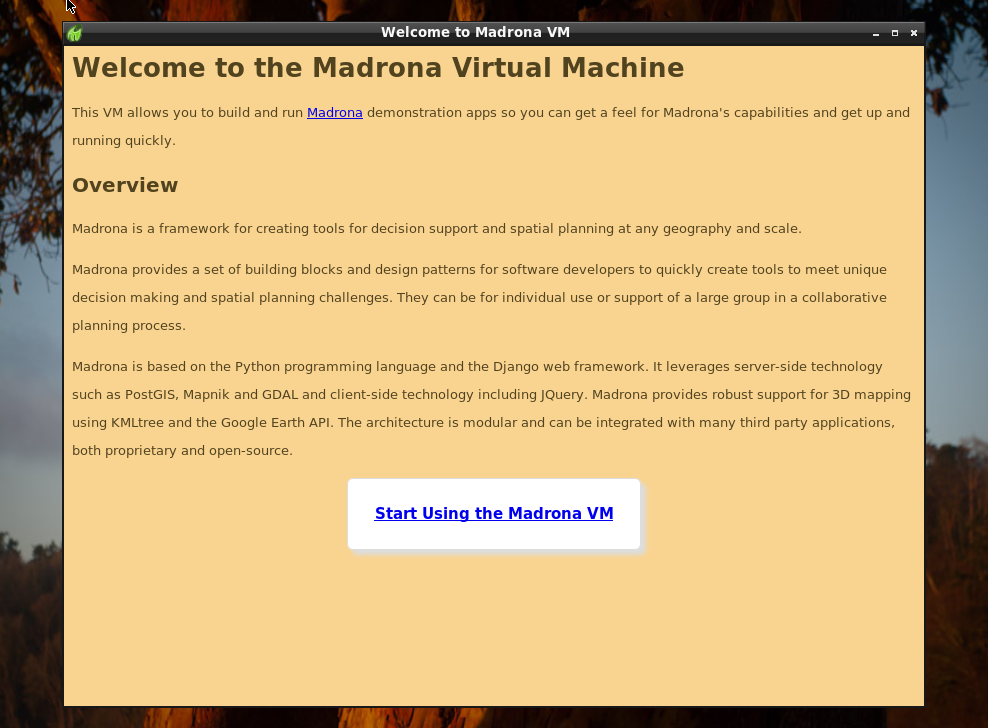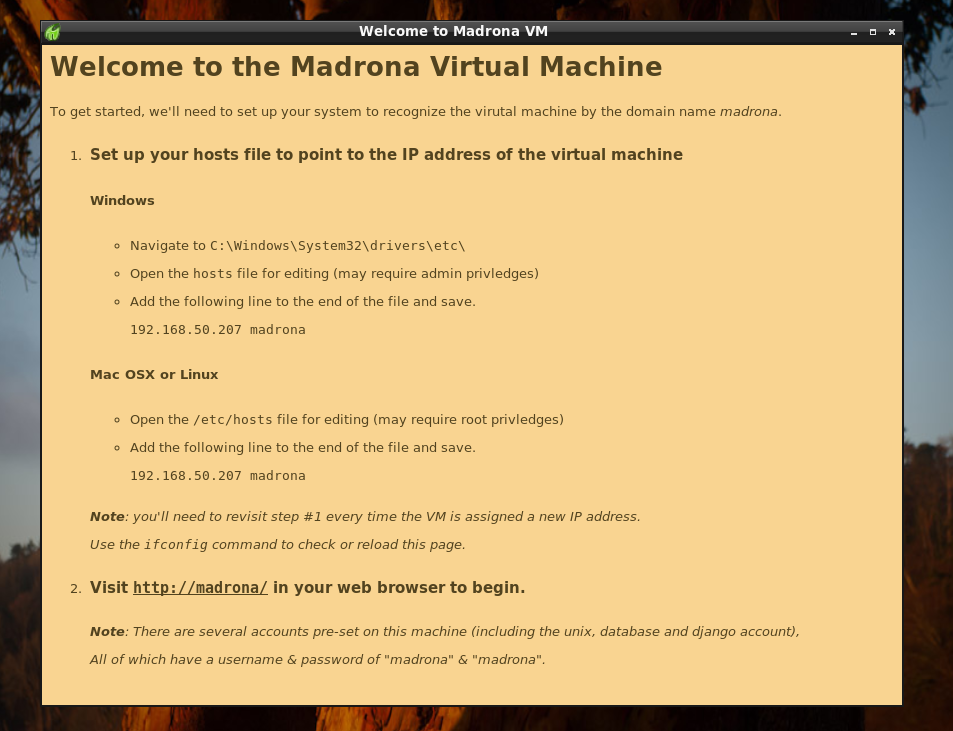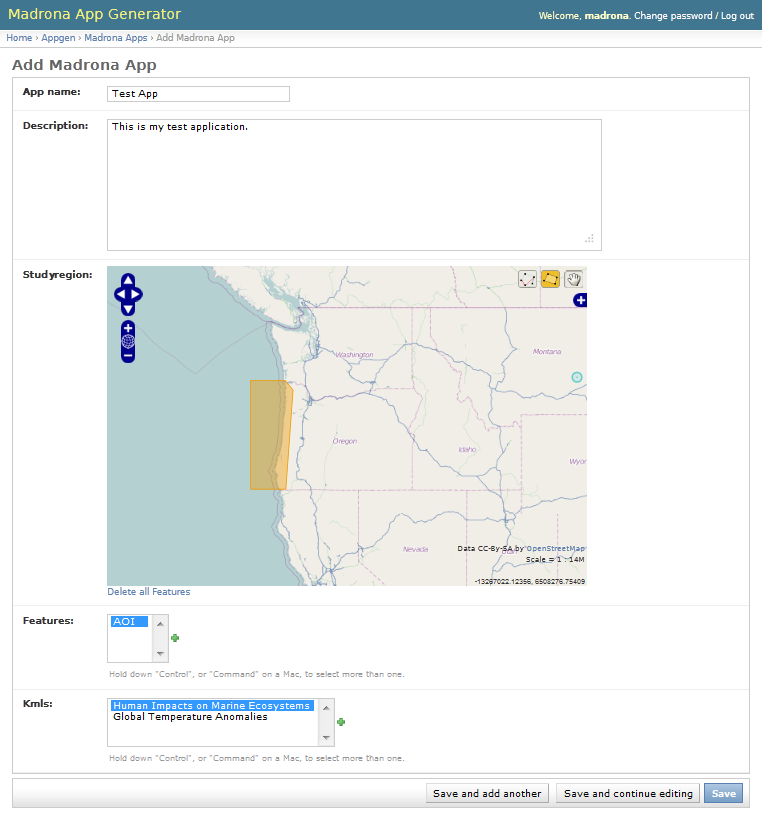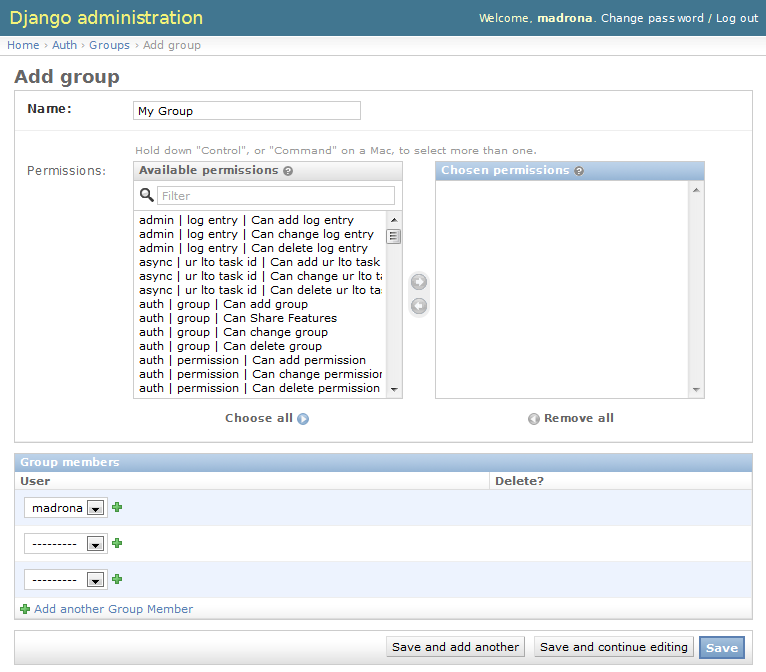Madrona Appliance Tutorial¶
Note
We assume you’ve already downloaded and installed the Madrona Appliance and have a virtual machine (VM) up and running.
This tutorial will walk through:
- Creating an app using the Madrona App Generator
- Getting started customizing the app
- In your running VM, click “Start Using the Madrona VM”

- The App Generator is now running. Follow the instructions onscreen to configure your host system to send web requests for ‘madrona’ to the VM’s IP address.
Note
this IP address could be different every time you start the VM and you will need to change it.

Creating the initial demo app¶
Now that your networking is setup, access the app generator from a web browser in your host operatings system (not the VM).
Note
Why access it from your host system? The demo uses the Google Earth Web Plugin which isn’t available currently for Linux.
- Open the URL http://madrona/
- Sign in. The username and password is madrona / madrona.
- Click Generate New Madrona App to begin.
- Provide the App with a name, we’ll be using “Test App” throughout this tutorial.
- Enter the description Test Application or whatever you want.
- Draw a study region on the map. The studyregion is used to define the geographical extent of your project. For best results, draw a smaller region.
- Under Features, select the AOI feature.
Note
Features are spatial entities that the user will be able to draw, edit and share with other people.
- (Optionally) create one or more additional features by clicking the ‘+’ button. Give them a name and a type (point, line, polygon or folder).or create your own by clicking the ‘+’ button. Once you create more you need to select them all in the Features list by holding down the Ctrl key and selecting them all.
- Select one or more of the available KML data layers to make available to your user.
- (Optionally) Click the “+” button to add your own KML file if you know the URL.
- Click Save. You should now see a summary of your app.

Initialize and Activate Your App¶
- Click Initialize This can take up to a minute. Be patient...
Note
Under the hood this is generating the code for your app using some simple commands. To see what the actual commands look like click the toggle code link.
- Once initialization is complete you will see an Activate button. Click the Activate button.
Note
Under the hood this is configuring the Apache web server to make your app available on port 81. You can only have one app active at one time.

Test Out Your New App¶
- In the admin, click Go To App. This will take you to http://madrona:81/. When the app loads it will automatically zoom the map to the study region that you drew.
Note
Loading may take a little while the first time as it caches your requests in order to speed up subsequent loads. If you don’t already have the Google Earth Web Plugin installed you will be asked to at this time. Once you do, refresh the page
- Click Login in the top right. The username and password is madrona / madrona
- Click the Data Layers icon in the top left.
Note
This is next to the Tools icon which looks like a gear.
- You should see a Test App folder which has a data layer for your study region. Try turning this on and off. Double-click to zoom into it.
- You should also see a Base KML Data folder which has all of the data layers that you added. Try turning them on and off.
- Now let’s create some features. Click the My Shapes tab in the top left. If you don’t see this tab you probably aren’t logged in.
- Click Create and then click AOI which generically stands for Area of Interest.
- Click Draw Shape and then draw a polygon on the map. Double-click the last point to finish.
Note
Madrona will now validate your shape, make sure you didn’t draw any bowties or any other type of self-intersecting polygon. If it’s valid you now have the option of editing your shape or if you are happy click Next.
- Give your new feature a name, any name. Optionally, give it a description.
- Click Submit
- You’ll now be presented with detailed information for your shape. Close this window by clicking the ‘X’.
- You should now see your feature in the Features and Collections
- Now let’s create a new folder. Do it the same way you created an AOI, through the Create menu.
- Click and drag your feature you created into your new folder. You can organize your features any way you like.
Note
There are many more things you can do with these features and folders out of the box including edit, delete, copy, share and download. Try selecting one or more features or folders and performing these actions, for example download an entire folder of features as KML.
Viewing and editing the generated code¶
Now we’ll go back to the Virtual Machine window to see the code that was generated through this process.
- The icon in the lower-left is your “Start” button. Yes it looks a little strange. Click Start > Accessories > LXTerminal to open a command line terminal window
- Click Start > Accessories > Sublime Editor 2. This will be your text editor
- In Sublime Text click File > Open Folder and then open /usr/local/userapps/testDemoProject/testdemoproject

Now you’re ready to begin customizing the app.
Customizing the Madrona project¶
The following sections will expose you to the django admin, django templates and models, and basic KML.
Running the development server¶
The application is currently running on a production web server which is ideal for publishing a site to the public. However, it is not convient for development; for that we have a special development server which is more suitable for tweaking.
In your LXTerminal window, change to the django app directory:
cd /usr/local/userapps/testappDemoProject
Then, run the development server with the following command:
python manage.py runserver 0.0.0.0:8000
From this point on, you will access your application at http://madrona:8000
Group Collaboration¶
Madrona provides a robust mechanism for sharing features between users. By default, all features you create under a single account are accessible by that user alone. But users can be made members of groups and can choose to share features with group members who can then view them, copy them, share them back with revisions, etc. This allows for truly collaborative multi-user workflows while maintaining privacy of data.
The first step is to use Django’s admin site to create users and groups.
- Navigate to http://madrona:8000/admin/auth/ and click + Add next to Groups. Give the group a name, “My Group”, and add the “madrona” user to it, and click Save.

Of course you, the “madrona” user, are the only member of this group at the moment! Go back to http://madrona:8000/admin/auth/ and click + Add next to Users and follow the instructions on-screen to create another user and add them to the My Group group.
At the command line prompt (LXTerminal), stop the development server by hitting Ctrl-C and type this command to enable sharing for all available groups:
python manage.py enable_sharing --all
Finally, restart the developement server by typing:
python manage.py runserver 0.0.0.0:8000
Go back to your host web browser and reload your application. You should now be able to share features with other users through the Edit > Share menu item and view shapes that others have shared in the Shared with Me tab.
About page¶
In your text editor, open /usr/local/userapps/testappDemoProject/testappdemoproject/templates/news/about.html. This is a Django HTML template. It generates the default landing page which by default is just a placeholder; you can put any html description or documentation that you wish and it will be the first thing they see when they first view the site. Change the text to the following:
{% load appname %}
<h1> About {% appname %}</h1>
<p> This app exists as an example to highlight some of the functionality
of the Madrona framework. </p>
Verbose name¶
The first obvious step is to change how our feature name appears on screen. We can supply custom text using verbose_name in the feature’s Options class. Give yours a verbose_name of ‘Areas of Interest’:
@register
class AOI(PolygonFeature):
description = models.TextField(null=True, blank=True)
class Options:
form = 'testapp.forms.AOI'
verbose_name = 'Areas of Interest'
Other Options are available, see the Feature options docs.
Generating custom reports¶
The default template for the AOI feature (what you see when you double-click a feature under My Shapes) just prints out some basic details by default including: the feature name, who created it, when they created it, the description, the area of the AOI, etc. Let’s customize it and report the acreage for the polygon.
In your text editor, open /usr/local/userapps/testappDemoProject/testappdemoproject/templates/aoi/show.html. There you will see a django html template responsible for creating the attributes page.
In your AOI model, below your verbose_name, add a new property called acres that returns acreage as seen below:
@register class AOI(PolygonFeature): description = models.TextField(null=True, blank=True) class Options: form = 'testapp.forms.AOI' verbose_name = 'Areas of Interest' @property def acres(self): area_meters = self.geometry_final.area conversion = 0.000247105381 area_acres = area_meters * conversion return area_acres
Save that file. Now add the new information to your feature’s show template. In your text editor, open (/usr/local/userapps/testappDemoProject/testappdemoproject/templates/aoi/show.html)
Insert the following at line 15, just below the reporting of Polygon Area and above the line break <br/>. instance refers to the current AOI feature being reported on:
<p>Acreage is {{instance.acres}}</p>Save that file. Now refresh your browser. Double-click one of your AOI features you created under ‘My Shapes’. You will now see that acreage is reported.
The reporting can get as detailed and complex as your needs require and can leverage GeoDjango geometry operations as well as any spatial analysis supported by Python.
Customizing KML styling¶
Every feature class has a default kml and kml_style properties which defines the KML representation of that feature. If you want to customize the look and behavior of your map features, you can override the kml property in your feature model. In testapp/models.py:
@register
class AOI(PolygonFeature):
description = models.TextField(null=True, blank=True)
class Options:
form = 'testapp.forms.AOI'
verbose_name = 'Areas of Interest'
@property
def kml(self):
return """
<Placemark id="%s">
<name>%s</name>
<styleUrl>#%s-default</styleUrl>
<ExtendedData>
<Data name="name"><value>%s</value></Data>
<Data name="dsc"><value>%s</value></Data>
<Data name="acres"><value>%s</value></Data>
</ExtendedData>
%s
</Placemark>
""" % (self.uid,
self.name,
self.model_uid(),
self.name, self.date_modified, self.acres,
self.geom_kml)
@property
def kml_style(self):
return """
<Style id="%s-default">
<PolyStyle>
<color>ffc00000</color>
</PolyStyle>
<BalloonStyle>
<bgColor>ffeeeeee</bgColor>
<text> <![CDATA[
<font color="#1A3752"><strong>$[name]</strong></font>
<p>Area: $[acres] acres</p>
<p>$[desc]</p>
]]>
</text>
</BalloonStyle>
</Style>
""" % self.model_uid()
The above will change the color and transparency of the polygon and modify the contents of the KML placemark balloon (showing Name, Description and Acres).
Ultimately, whatever you can do with KML , you can do with your feature’s KML representation. However, there are some important guidelines to follow; For more information, see the kmlapp documentation.
Handling geometries through manipulators¶
The manipulators app provides ways to validate user-drawn geometries and make sure they conform to rules that you define. For example, you may want to limit user-drawn shapes to be within the study region. For this case, there is a built in manipulator called ClipToStudyRegion which will, as the name suggests, clip a user-drawn shape to the coundary of the study region:
@register
class AOI(PolygonFeature):
description = models.TextField(null=True, blank=True)
class Options:
form = 'testapp.forms.AOI'
verbose_name = 'Areas of Interest'
manipulators = [ 'madrona.manipulators.manipulators.ClipToStudyRegionManipulator' ]
You can also choose from several other built-in manipulators, define custom manipulators or make them optional. For more information, see the manipulators documentation.
Managing basemaps and KML datasets¶
Base data layers are managed using a single KML file called the public layers list. If you defined KML layers when setting up your initial app, the layers list will be available at http://madrona:8000/admin/layers/publiclayerlist/1/ . Download the public.kml file and open it in a text editor. You’ll see that it is a standard KML file with `NetworkLink`s to the base data layers. We can modify it by adding another KML NetworkLink:
<NetworkLink id="global-marine">
<name>Global Marine</name>
<visibility>0</visibility>
<Link>
<href>http://ebm.nceas.ucsb.edu/GlobalMarine/kml/marine_model.kml</href>
</Link>
</NetworkLink>
Once we’ve modified the public kml, browse to admin interface at http://madrona:8000/admin/layers/publiclayerlist/add/ and use it to upload the new KML file. After refreshing your browser cache, you should see the new KML avaible in the layers panel.
For more information, see the layers documentation.
Custom Links: Extending the API¶
Many default API actions are defined out-of-box for Madrona Features (Create, Edit, Delete, KML download, etc.). If you want to provide other methods of accessing your features, Madrona provides a link option to extend the API.
For example, let’s say we want to provide a simple text file download for your area of interest. This would involve two steps:
Add a link to your feature Options in testapp/models.py:
from madrona.features import alternate @register class AOI(PolygonFeature): description = models.TextField(null=True, blank=True) class Options: form = 'testapp.forms.AOI' verbose_name = 'Areas that interest me' manipulators = [ 'madrona.manipulators.manipulators.ClipToStudyRegionManipulator' ] links = ( alternate('Text file', 'testapp.views.aoi_text', select='single multiple', type='text/csv' ), )
Create a view to handle the creation of text files for one or more features. Open testapp/views.py and add the following function:
from django.http import HttpResponse def aoi_text(request, instances): text = "Name, Description, Acres\n" for f in instances: text += "%s, %s, %f\n" % (f.name, f.description, f.acres) return HttpResponse(text)
Now restart the application, clear the cache and you should see Text File as an option in the download menu.
Note
There are many default links provided by madrona - just think of all the work you’d have to do to a) manually create the views and urls to handle them and b) tweak the javascript and html to handle all of those views. Madrona just does it for you... nice, huh!
For more information about extending the API through links and views, consult the Features documentation
Next Steps¶
See the documentation in the following sections to customize Madrona as needed:
- madrona.features - Spatial Content Management of Features
- madrona.studyregion - The Study Region
- Deployment
- madrona.layers - KML Data Layers
- Managing Users in Madrona
- Migrations for Database Schema Changes
- madrona.manipulators - Manipulators
- madrona.staticmap - Static Map Data Layers
- Sharing Features and Collections
- Template Customization
The setup this guide has walked through only specifies how to run the django development server. To setup a public facing website using Apache, consult the Deployment notes.